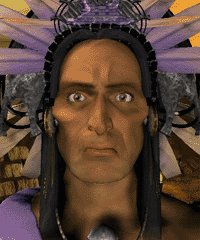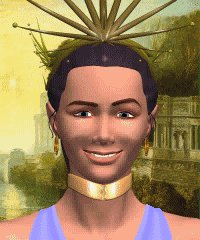I did alittle research on the Navajo, and have gathered a decent history for them:
The following information was taken from
http://americanhistory.about.com/library/prm/bllongwalk.htm
Back in the 1830s, President Andrew Jacksons Indian Removal Act led to a forced westward march of the Southeastern-based Cherokees by the U.S. Army that has become known as the Trail of Tears. Exhaustion, hunger, disease and severe weather took a toll on the Cherokees, one of the Five Civilized Tribes. As horrible as that experience was for the Indians involved, it did not cause most U.S. government officials to shed tears. Such Indian removals, most of them to Indian Territory (present-day Oklahoma) from the East or the North, would be repeated many times with many different Indian groups in the years to come
One of the few west-to-east forced marches involved the Navajos in the 1860s, and though the distance involved (375 to 500 miles, depending on the route) was considerably shorter than some of the other forced marches, it has become known as the Long Walk. Besides having a catchy name, it also involved Kit Carson, who traditionally has been viewed as an American hero. Controversy surrounds Carsons role in the Long Walkactually a series of walks, mostly made early in 1864, from Fort Canby (near present-day Window Rock, Ariz.) to confinement at the Bosque Redondo in eastern New Mexico Territoryand controversy also surrounds the entire Navajo campaign of 1863-64. But no matter how necessary or misguided it all was, there is no doubt that the Long Walk periodfrom 1863 to 1868, when the Navajos were finally allowed to return to their homelandwas one of the darkest and most significant times in Navajo history.
The Navajo people (or Diné), like the Apaches, are of Athapaskan descent and probably migrated south to the American Southwest about 1300, although archaeological evidence suggests that some Athapaskan-speaking tribes arrived in the Four Corners region of Arizona, New Mexico, Colorado and Utah as early as the 8th century. Oral tradition holds that the ancestors of the Navajos were already in Dinétah (the traditional Navajo homeland) when the Anasazi were building in Chaco Canyon between the years 900 and 1130.
The Navajo conflicts that led up to the Long Walk began with the Spanish conquest of the Southwest in the 16th century. Before the Conquistadors arrived, the early Navajos apparently coexisted with their Pueblo Indian neighbors fairly well, though raids were sometimes carried out. The Navajos, seminomadic hunters, adopted some Pueblo culture and learned farming from the Pueblo tribes. Spanish missionaries had almost no success with the Navajos, but the Navajos did take an interest in Spanish horses and guns and, as a result, their interest in raiding grew. Sometimes the Navajos raided the Spanish colonists, and sometimes they traded with them. But they were far enough away not to feel too threatened by the Spaniards. The Pueblo Indians had it worse. Spanish soldiers and priests were living among them, forcing the Indians to forego their traditions and to worship the Spanish God. To seek refuge from their heavy-handed masters, some Pueblos ran off to join the Navajos.
In 1680, the Pueblo people revolted against their masters and drove them away from New Mexico, but all their problems did not disappear with the Spaniards. The Navajos, mounted on horses, increasingly raided Pueblo villages. In some cases, Spanish soldiers had been providing protection from these raids. Not that the Pueblo Indians wanted the white men to return, but return they did in 1692. When the Spanish reconquered New Mexico, many Pueblos again fled to live with friendly Navajo bands. This cultural mix led to the Navajos learning many new things, including how to raise sheep and goats. In time, as the Spaniards took a kinder approach to the Pueblo Indians, many of the Pueblo families that had taken up residence in Dinétah returned to their pueblo homes. By the early 1700s, most Pueblos were siding with the Spaniards, who could help fight off Navajo, Apache and Ute raiders. At the same time, the Spanish, sometimes with Pueblo assistance, were busy capturing Navajo women, children and livestock. By the end of the 18th century, the Navajos were also dealing with equally troubling raids by Utes, Comanches, Jicarilla Apaches and Mescalero Apaches. Many Navajos packed up and drove their flocks to more peaceful grazing grounds to the west.
After the Mexicans took over New Mexico from the Spanish in 1821, nothing immediately changed for the Navajos. The vicious raiding cycle continuedthe Navajos would raid and then the soldiers (now Mexican instead of Spanish) raided back. Attempts by various men on both sides to make peace in the 1830s and early 40s largely failed. And then came the Americans, who rode into Santa Fe in August 1846 and made themselves at home. That November, Navajo leaders met with American soldiers and signed the Bear Springs Treaty. But peace was not possible. Many New Mexicans and Navajos were still at war, and the Americans provided almost no protection for the Indians against Hispanic settlers who raided to gain slaves or livestock.
As early as 1850, Indian agent James S. Calhoun suggested the Navajos, Apaches and Utes be put on reservations. After being appointed territorial governor in 1851, Calhoun authorized New Mexican militia to campaign against the Navajos. As a reward, the militiamen were allowed to take slaves. The Navajos, of course, retaliated by stealing more livestock. The Americans built Fort Defiance (in present-day northeastern Arizona) in an attempt to stop Navajo raids. It didnt. Manuelito, Barboncito and other Navajo leaders called for an attack on the fort, which was carried out on April 29, 1860. One soldier was killed in the fight. All the soldiers left Fort Defiance a year later, but they didnt go far. In 1862, near Bear Springs (in present-day northwestern New Mexico), they built what became known as Fort Wingate. But by then, most soldiers and New Mexicans had bigger concerns than the Indians. The Civil War was on, and Rebels from Texas had invaded their territory.

 ) I thought she might be useable as Pocanhontas; not really Native American, but good enough IMHO.
) I thought she might be useable as Pocanhontas; not really Native American, but good enough IMHO.


 ) I thought she might be useable as Pocanhontas; not really Native American, but good enough IMHO.
) I thought she might be useable as Pocanhontas; not really Native American, but good enough IMHO.




 )
) ?
? ?
?


 I read that, but my eyes don't tolerate such a beating.
I read that, but my eyes don't tolerate such a beating.